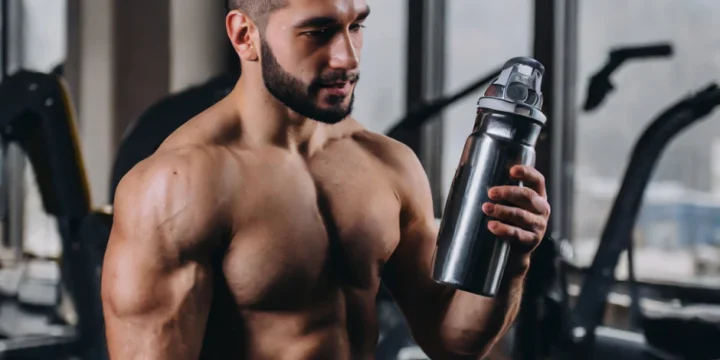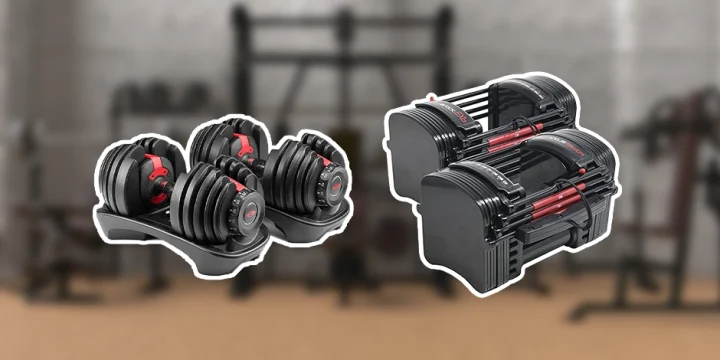The bench press is the go-to exercise for the majority of power athletes and bodybuilders. So, many of them are caught off-guard when wrist pain shows its ugly face.
As a fitness trainer with over a decade of experience, I've seen all kinds of wrist injuries. However, I've also found ways to prevent and address them.
Whether you're a beginner or an advanced lifter, keep reading to inform yourself about bench-press-related wrist pain so you can avoid it.
Let's dive in.
Quick Summary
- To prevent wrist pain while bench pressing, focus on correct hand placement, proper grip, and maintaining a neutral wrist angle.
- Wrist pain during bench pressing can manifest as thumb-side pain, pinky-side pain, palm pain, or back-of-the-wrist pain, each indicating different potential issues.
- According to WebMD, carpal tunnel syndrome is a common cause of wrist pain, often exacerbated by incorrect wrist positioning during exercises like bench pressing.
- Addressing wrist pain effectively involves a combination of technique adjustment, proper equipment use, and sometimes modifying your workout routine.
Anatomy of The Wrist
Before I get into the causes of wrist pain and how to avoid them, let's first understand the anatomy of the wrist.
Thanks to some help from my physiotherapist, I have some basic details you should know.
Structure

The first thing to note is that the wrist joint is made up of several smaller bones, which is why a fracture can become quite a serious problem.
The eight bones actually make up three main joints that all contribute to unique movement directions to allow your hands to make very precise actions.
Along with the complex combination of bones, there are multiple ligaments and discs that keep all of the bones in place and separated.
And just to make things even more complex, there are three different nerves that pass along the wrists to control different hand movements [1].
It kind of puts things into perspective as I watch my fingers type out this article.
Movement

Your wrists are able to perform some pretty complex movements that include flexion, extension, and adduction.
That’s what allows you to move your hand up and down at the joint, as well as slightly from side to side.
And because these joints can move in all directions, there’s a higher risk of pain from the incorrect use of your hands during exercise.
Now, let’s look at some different indications of wrist pain.
Symptoms of Wrist Injuries

My physiotherapist has given me some basic information on how he diagnoses clients who complain of wrist issues from bench pressing.
Don’t worry; I’ll leave all the technical and medical terms out and just explain what to look for.
1. Thumb-Side Wrist Pain
You might notice the pain on either the palm or the knuckle side, and it can range from a local throbbing to shooting nerve pain.
According to Mayo Clinic, the cause of this can vary from stress fractures to arthritis in the joint at the base of the thumb [2].
Apparently, arthritis is more common than I thought, and if you feel like the pain gradually increases the more you grip a bar, then this might be something to have properly diagnosed.
2. Pinky-side Wrist Pain
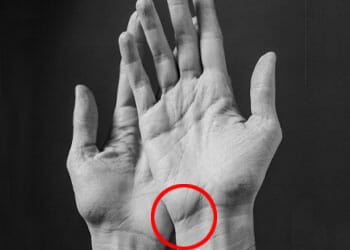
Similar to the above thumb description, you might feel pain on the palm or knuckle side.
Again, it could be down to stress fractures, but those are less common unless you’ve had a fall or other sudden injury.
What’s more likely is some form of long-term strain, which is common with people who work with their hands or bench press a lot.
3. Pain Towards The Palm
According to WebMD, carpal tunnel syndrome is possibly the most common type of pain in the wrists [3].
It can be a throbbing pain or numbness that extends from the wrists into the hands and is mainly caused by one of the nerves becoming compressed.
“Anything that causes the body (specifically, the tendons and/or tenosynovium) to swell or retain water—and therefore, causes the carpal tunnel to narrow—can be linked to carpal tunnel syndrome.”
- Gabrielle Kassel, Wellness Writer
Often, the discomfort can get worse when your wrists are resting.
4. Pain At The Back Of The Wrist
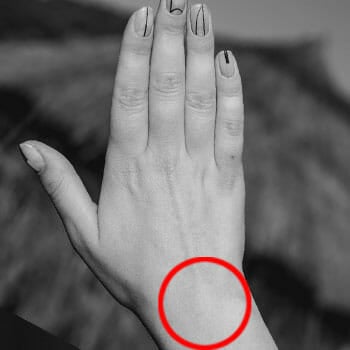
This type of pain in your wrists is most often down to long-term damage to the bones.
One way this can happen in normal life is if your daily work routine involves constantly lifting heavy and awkwardly shaped objects.
It’s also more common in powerlifters than just doing a standard bench press exercise, but it’s worth keeping an eye on.
If you regularly feel such pain, then make sure you read the following section to take a close look at how you grip the bar.
Main Reasons For Feeling Pain While Bench Pressing
My strength coach on the college rowing team spent a lot of time with me to work on lifting techniques before he allowed me to start piling on the weights. It’s why I’ve rarely suffered from bench press wrist pain, and here’s how you can achieve the same.
1. Position Of The Bar On Your Hands
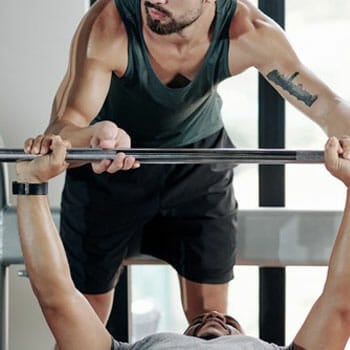
When you set yourself up for a barbell bench press, the first thing you should focus on is your actual hand grip.
If you hold the bar too high towards the top of your palm, then you can end up in a starting position that causes too much wrist extension.
And when the bar is too far towards the base of your palm (sometimes called the bulldog grip), then a lot of the weight transfers towards the thumb, with both situations causing a lot of wrist pain.
Make sure the bar is below the midsection of your palm and that the wrists are only slightly extended.
2. Incorrect Use Of Fingers
I’ve seen this a few times with amateurs who complain of discomfort in their wrists, usually around the thumbs.
Somehow, they decide that it’s a good idea to grip the bar without wrapping the thumbs around the front.
Some call it the thumbless grip; I just call it crazy.
The thumb plays an important role in securing the bar and making sure it doesn’t roll off the hands.
And beyond being a safety issue, this approach doesn’t fully lock your wrists, meaning that the weight isn’t fully transferred to the chest muscles you’re trying to target in the first place.
Basically, avoid the thumbless grip.
3. Angle of The Wrists
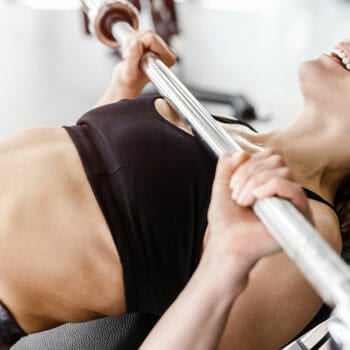
This is another common mistake. People often extend their wrists too far before they even get the bar off the rack.
Some wrist extension is necessary, and the angle of the wrists will change slightly throughout the movement.
But by starting in the wrong position, you’re setting yourself up for a lot of problems.
One way to overcome this is to use tight wrist wraps that hold the wrist joints in an optimum position.
4. Open Grip Position
Another common cause of wrist discomfort during a bench press is your grip width. If you place your hands too far apart, then you reduce the range of motion and the directions your wrists move.
The result of a wide grip width is added strain and a reduced transfer of weight to the pecs [4].
“Placing your hands excessively wide to mimic elite powerlifters sets you up for wrist pain. These lifters use wrist wraps to help support their joints and have trained over time to bear this position. A wide grip puts your wrists outside of your elbows, which increases the pressure on them.”
- Andrea Boldt, Writer at SportsRec.com
When you’re setting yourself up for bench pressing, get your grip width to slightly wider than shoulder-width.
5. Weight Load
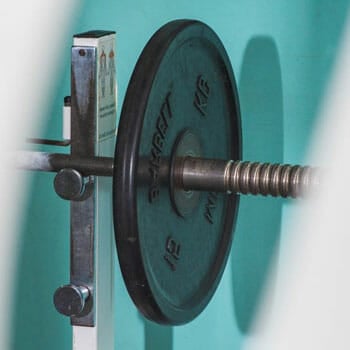
We all watch that lifter at the gym who can bench hundreds of pounds.
But what I always tell my clients is that those guys didn’t get there by training beyond their capabilities.
Instead, they pick a weight that allows them to maintain perfect technique.
So, if you’ve noticed a sudden increase in wrist pain, take a step back and lower the weight.
Improve your technique and slow down the movements, and you could quickly realize that this was the cause of the discomfort.
You can also try these bench press alternative exercises.
Should You Bend Your Wrists For Bench Press?

No, you shouldn’t bend your wrists for bench press. However, you will still need to allow for a little extension.
Let me explain.
When people ask me about bending their wrists, they usually show me their wrists fully extended.
And that’s not a safe technique.
Throughout the movement, you may notice your wrists slightly extending, and that’s fine. But don’t allow this to go too far.
The best way to avoid this as an amateur or a heavy powerlifter is to put on some wrist wraps while bench pressing.
Wrist wraps work great to avoid over-extension, and they promote a much better technique.
How Do You Strengthen Your Wrists For Bench Press?

1. Strengthening Exercises
One of the best ways I have found to improve wrist strength is to do forearm curls.
Sit down on a bench with your forearm resting on your thigh. While holding a dumbbell with your palms facing up, curl your wrist up and down to build up more strength in your lower arms and wrists.
Then, switch the technique to having your palms facing down.
2. Stretching
Improving your range of motion is another excellent way to build up more strength in your wrist.
There are several ways to stretch the joint, and the simplest way is to stretch out one arm straight in front of you with the palm facing down.
With the other hand, pull the fingertips towards you and extend your joint. Then, switch to the position of the palm facing up to flex the joint.
3. Nutrition for Joint Strength
Nutrition plays a vital role in joint health, particularly for the wrists.
A study I found in the Mediterranean Journal of Rheumatology suggests that omega-3 fatty acids (found in foods like salmon and walnuts) can reduce inflammation [5].
Other supplements for joint health include glucosamine and chondroitin. Additionally, ensuring adequate protein intake is essential for muscle and tendon strength, which indirectly supports the wrists during bench pressing.
5. Mental Strategies for Training with Wrist Pain
Training with wrist pain requires not only physical but also psychological strategies.
It's important to listen to your body and differentiate between good pain (muscle fatigue) and bad pain (injury).
Mental techniques like visualization and positive self-talk can help in coping with discomfort.
However, it's crucial to avoid pushing through severe pain, as this can lead to long-term injuries.
FAQs
Should You Work Out With Wrist Pain?
No, you shouldn’t work out with wrist pain, or at least try to avoid any exercise that puts a lot of strain on the wrists. You should also consider using wrist wraps to avoid pain in the area.
Should You Try the Bulldog Grip for Wrist Pain?
Yes, you should try the bulldog grip for wrist pain. But I'd suggest trying the bulldog grip for a few sets with a light load so that you get used to the difference in balance across your palms.
Do Wrist Straps and Grips Help With Wrist Pain?
Yes, wrist straps and grips help with wrist pain, especially if the pain is due to a wrong angle on the joint. That's why many powerlifters rely on wrist wraps to ensure they keep an ideal angle.
Should You Switch to Dumbbells if Your Wrists Hurt?
Yes, you should switch to dumbbells if your wrists hurt, but I'd suggest fixing your technique and using wrist wraps first. The dumbbell bench press will give you an entirely different range of motion, which might not target the same muscles.
References:
- https://teachmeanatomy.info/upper-limb/joints/wrist-joint/
- https://www.mayoclinic.org/diseases-conditions/thumb-arthritis/symptoms-causes/syc-20378339
- https://www.webmd.com/pain-management/carpal-tunnel/carpal-tunnel-syndrome#1
- https://www.sportsrec.com/12682626/the-difference-between-the-shoulder-press-incline-press
- http://mjrheum.org/assets/files/792/file242_1161.pdf
About The Author
You May Also Like



